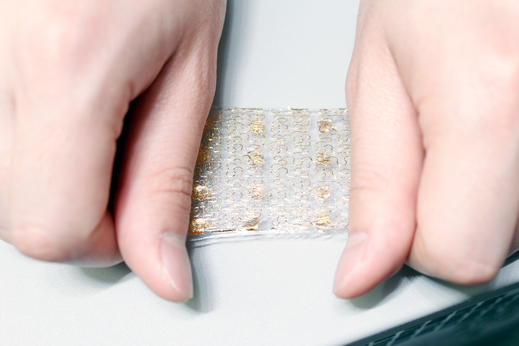Artificial Skin That Senses, and Stretches, Like the Real Thing
Some high-tech prosthetic limbs can be controlled by their owners, using nerves, muscles, or even the brain. However, there’s no way for the wearer to tell if an object is scalding hot, or about to slip out of the appendage’s grasp.

Materials that detect heat, pressure, and moisture could help change this by adding sensory capabilities to prosthetics. A group of Korean and U.S. researchers have now developed a polymer designed to mimic the elastic and high-resolution sensory capabilities of real skin.
The polymer is infused with dense networks of sensors made of ultrathin gold and silicon. The normally brittle silicon is configured in serpentine shapes that can elongate to allow for stretchability. Details of the work are published today in the journal Nature Communications.
Stretchable sensing materials have been in development for years (see “Stretchable Silicon” and “Making Stretchable Electronics”). But this is the most sensitive material yet, with as many as 400 sensors per square millimeter.
“If you have these sensors at high resolution across the finger, you can give the same tactile touch that the normal hand would convey to the brain,” says Roozbeh Ghaffari, who contributed to the research and heads advanced technology development at MC10, a startup in Cambridge, Massachusetts, developing wearable products based on flexible, sensor-laden materials.
What’s more, the researchers tuned the sensors to have the right stretching ranges depending where on a hand they’d be located. They used motion-capture cameras to study how a real hand moves and stretches, and then applied varying silicon shapes to different spots on the prosthetic skin to accommodate that stretchability.

Finally, in a further effort to make the materials seem more realistic, they added a layer of actuators that warm it up to roughly the same temperature as human skin.
The new smart skin addresses just one part of the challenge in adding sensation to prosthetic devices. The larger problem is creating durable and robust connections to the human nervous system, so that the wearer can actually “feel” what’s being sensed.
In a crude demonstration of such an interface, Dae-Hyeong Kim, who led the project at Seoul National University, connected the smart skin to a rat’s brain and was able to measure reactions in the animal’s sensory cortex to sensory input. This did not, however, show whether, or to what extent, the rat was feeling heat, pressure, or moisture. “To tell the exact kinds of feeling,” Kim says, “we need to move onto larger animals, which would be our future work.”
There remains a big gap between what the new materials can do and what existing interfaces can actually convey to the human brain, says Dustin Tyler, a professor of biomedical engineering at Case Western Reserve University, and an expert in neural interfaces. “This proof-of-concept demonstration is interesting, but there is a lot of hard work that remains to show the robustness and performance necessary to translate this device to usable prosthetic hands,” he says.
Only recently has an interface capable of restoring sensation been demonstrated in a human, when Tyler and colleagues equipped a Cleveland-area man who lost his hand with such a system (see “An Artificial Hand with Real Feeling”). The man could control the hand using a muscle interface, and some 20 sensors on the prosthetic hand relayed sensory information back to him through the electrode attached to a nerve in his arm stump. This allowed him to know if he’d picked up something soft like a cherry and to stop himself from crushing the fruit.
Deep Dive
Humans and technology
Building a more reliable supply chain
Rapidly advancing technologies are building the modern supply chain, making transparent, collaborative, and data-driven systems a reality.
Building a data-driven health-care ecosystem
Harnessing data to improve the equity, affordability, and quality of the health care system.
Let’s not make the same mistakes with AI that we made with social media
Social media’s unregulated evolution over the past decade holds a lot of lessons that apply directly to AI companies and technologies.
Stay connected
Get the latest updates from
MIT Technology Review
Discover special offers, top stories, upcoming events, and more.